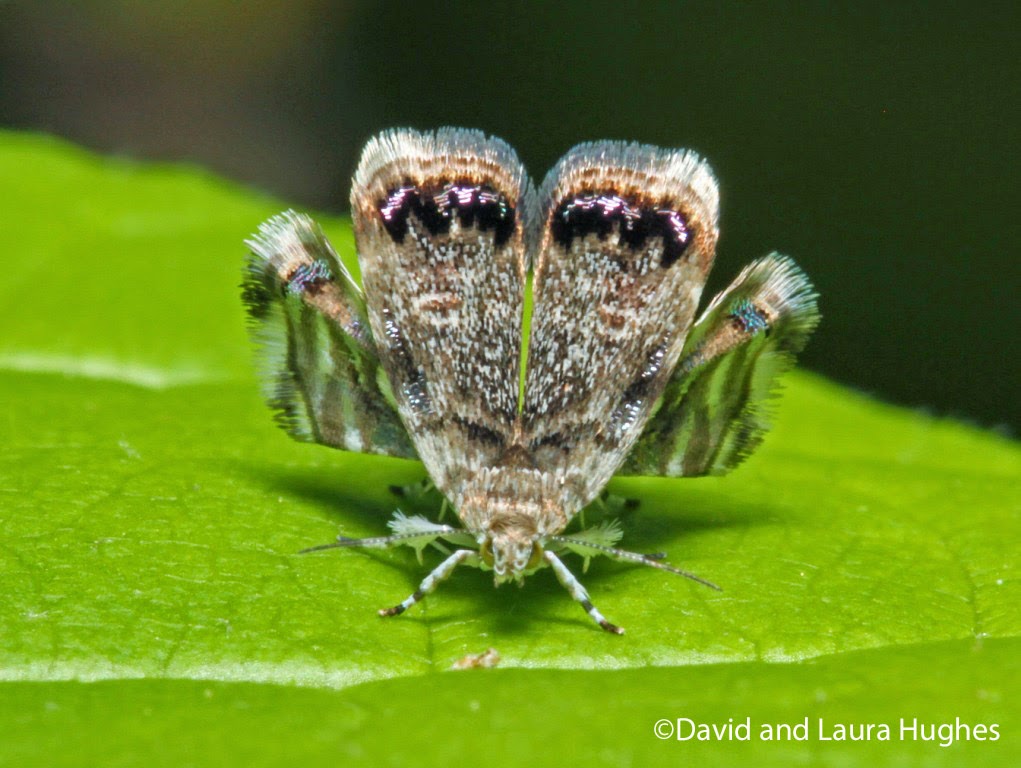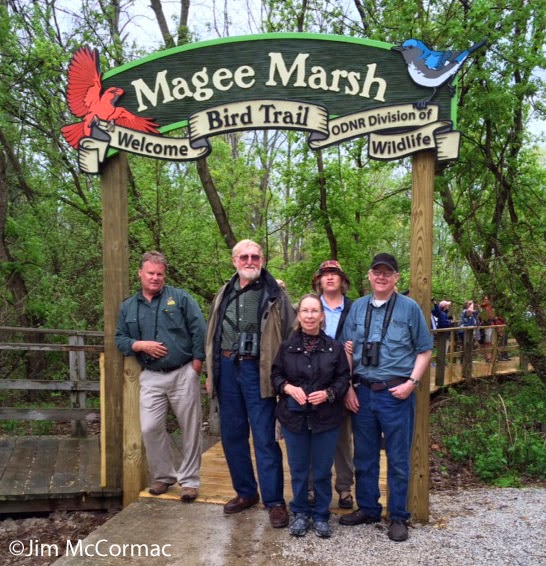We had a great time talking photography and watching numerous warblers and other songbirds move through the nearby trees. As a bonus, the cement pad at the hill's crest served as an attractant to hill-topping butterflies of many species.
On the hike up, and everywhere else we went that weekend, we noticed plenty of eastern tent caterpillars, Malacosoma americanum. This species is certainly one of our better known caterpillars, due to their habit of constructing conspicuous silken shelters. These caterpillarariums are nearly always placed in the fork of a black cherry tree, Prunus serotina, as is the one pictured. Tent caterpillars, which are the larvae of a rather handsome moth, seem to have boom and bust years. Some years the silk nests are seemingly everywhere, others relatively few can be found.
Most caterpillars go through five growth phases, each one termed an instar. At least two and perhaps three different instars are present in this photo. Following each instar, the caterpillar sheds its skin and emerges larger. Following the ultimate instar, it fashions a cocoon in which it will transform to the adult moth.
The silken tents in which the animals live communally until their last instar serve several purposes. Foremost, the dense sticky silk offers superb protection from would-be predators, especially parasitoid flies and wasps. Both are prolific enemies of caterpillars. Also, most songbirds will not deal with the dense silk, so for the most part the caterpillars are also safe from the feathered crowd.
Come nightfall, and the temporary disappearance of most of the birds, flies, and wasps, the caterpillars emerge from the nest and radiate out into the tree to feed on cherry foliage. Come dawn, they crawl back into the shelter of the nest. The tent probably also serves as a sort of greenhouse, with an elevated internal temperature that speeds the digestive process of the caterpillars within. Note all of the little blackish flecks in the silk - that is all frass, or caterpillar poo.
A fully grown eastern tent caterpillar is rather handsome, painted as it is in blue, gold, black, and white. Nonetheless, it is mostly maligned by people who resent what they consider to be unsightly silken nests. Let it be noted, though, that this is a native animal and its depredations on cherry trees seldom do any lasting damage. And as we shall see, some interesting and generally much more appreciated animals make much use of the tent caterpillars.
Most birds do have trouble eating them, as the long stiffish bristles of the caterpillar will eventually clog up their digestive tracts. Most famous of the tent caterpillar-eating birds are the cuckoos, who seemingly eat them with impunity. This is because Black-billed and Yellow-billed Cuckoos can slough off and cast out their stomach linings if they become too spiked with caterpillar bristles. The bird is able to regrow its stomach lining and thus can regularly consume the bristly meals. For the most part, with at least one notable exception, it seems to be the cuckoos that are the primary avian predator of eastern tent caterpillars.
Anyway and finally, to the object of this article. We had not long been atop the hill when we spotted a gorgeous male Baltimore Oriole fly into a nearby tree. Knowing the the colorful blackbirds were also fond of snacking on tent caterpillars, I suggested that Brian and Dane train their lens on a nearby, particularly scrumptious caterpillar nest. Sure enough, a couple minutes later the oriole dropped through the branches and approached the nest.
Dane, with his mega lens and skills at finding objects through blowing leaves and branches, managed a great series of shots, and he was kind enough to share them with us. In the photo above, the oriole has just alit and is inspecting the nest for victims.
One thing that I was always curious about was how orioles managed to eat bristly tent caterpillars without doing harm to their digestive tracts. Cuckoos, as we know, can simply regrow bristle-clogged parts, but insofar as I know, orioles do not have this ability. I was hopeful that a nice series of photos might cast light on the oriole's tentside culinary practices.
We can see in the above photo that the oriole has apparently pierced the skin of the caterpillar, and is drawing out the prized innards.
It appeared to us, and Dane's photos seem to illustrate this, that the oriole uses its sharp, finely pointed bill to neatly slice open a slit in the caterpillar, from which it could draw out the inner contents.
You can see the oriole tugging out the guts, as it were, without the need of swallowing the whole package bristles and all.
Like slurping a strand of spaghetti from a tubular plate. Baltimore Orioles are certainly known to dine on tent caterpillars, but I've never seen the techniques by which they do so explained. Thanks to Dane's fine photographs coupled with our field observations, it appears to be a matter of careful dissection and surgical extraction, thus avoiding the bristly outer skin.
Even the most reviled native animals, such as tent caterpillars, have value. Our superficial condemnation is often unjustified and all too frequently based on ignorance.
Thanks to Dane for sharing his great series of photos.
_edited-1.jpg)
_edited-1.jpg)
_edited-1.jpg)
_edited-1.jpg)



















.JPG)





.jpg)



.jpg)
















.JPG)
.JPG)
.JPG)
.JPG)
